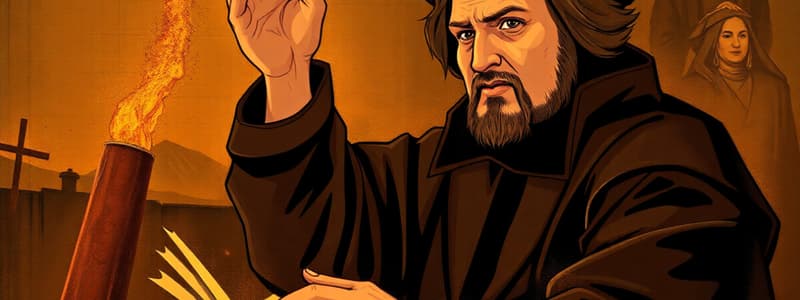Podcast
Questions and Answers
How did the printing press significantly contribute to the spread of the Protestant Reformation?
How did the printing press significantly contribute to the spread of the Protestant Reformation?
- It improved the quality of musical instruments used in Protestant church services.
- It facilitated the creation of religious artwork, inspiring people to join the movement.
- It enabled more accurate mapping of territories, aiding the organization of reform movements.
- It allowed for the mass production and distribution of reformers' writings, increasing accessibility and challenges to Catholic teachings. (correct)
What was the significance of the Council of Trent in the context of the Reformation?
What was the significance of the Council of Trent in the context of the Reformation?
- It facilitated peace negotiations between Catholic and Protestant factions.
- It established a new set of guidelines for Protestant worship and governance.
- It was a key component of the Catholic Church's Counter-Reformation, aimed at addressing internal issues and reaffirming Catholic doctrine. (correct)
- It formalized the split between the Catholic Church and emerging Protestant denominations.
Which European political development was significantly influenced by the weakening of papal authority during the Reformation?
Which European political development was significantly influenced by the weakening of papal authority during the Reformation?
- The rise of feudalism, as local lords assumed religious duties.
- The strengthening of the Holy Roman Empire under the Pope's guidance.
- The rise of nation-states, with rulers increasing control over religious matters within their territories. (correct)
- The establishment of a unified European Parliament to resolve religious disputes.
How did the Protestant Reformation impact literacy and education in Europe?
How did the Protestant Reformation impact literacy and education in Europe?
What role did political leaders, such as German princes and Henry VIII, play in the Protestant Reformation?
What role did political leaders, such as German princes and Henry VIII, play in the Protestant Reformation?
Which of the following best describes the long-term global impact of the Protestant Reformation beyond Europe?
Which of the following best describes the long-term global impact of the Protestant Reformation beyond Europe?
How did the Reformation contribute to the development of secularism?
How did the Reformation contribute to the development of secularism?
What was Martin Luther's initial catalyst for starting the Protestant Reformation in 1517?
What was Martin Luther's initial catalyst for starting the Protestant Reformation in 1517?
What was the nature of the conflicts that arose as a result of the spread of the Reformation?
What was the nature of the conflicts that arose as a result of the spread of the Reformation?
How did the Reformation contribute to later political revolutions, such as the American and French Revolutions?
How did the Reformation contribute to later political revolutions, such as the American and French Revolutions?
Flashcards
Protestant Reformation
Protestant Reformation
A movement in the 16th century that sought to reform the Catholic Church, leading to the establishment of Protestant churches.
Indulgences
Indulgences
Pardons sold by the Catholic Church that were criticized by Martin Luther.
Martin Luther
Martin Luther
German monk who initiated the Protestant Reformation by posting his 95 Theses.
95 Theses
95 Theses
Signup and view all the flashcards
The Printing Press
The Printing Press
Signup and view all the flashcards
Wars between Catholics and Protestants
Wars between Catholics and Protestants
Signup and view all the flashcards
Counter-Reformation
Counter-Reformation
Signup and view all the flashcards
Council of Trent
Council of Trent
Signup and view all the flashcards
Protestantism
Protestantism
Signup and view all the flashcards
Secularism
Secularism
Signup and view all the flashcards
Study Notes
- The Protestant Reformation started in the early 16th century, driven by corruption within the Catholic Church, notably the sale of indulgences and the extensive papal authority.
- Martin Luther, a German monk, began the Reformation in 1517 by posting his 95 Theses, which criticized Church practices and advocated for reforms.
- The printing press facilitated the rapid spread of the Reformation by widely circulating Luther's writings.
- The printing press allowed religious texts, including the Bible, to be more accessible, thus encouraging people to question traditional Catholic teachings.
- German princes protected Luther, viewing Protestantism as a means to gain independence from Rome.
- Henry VIII's split from the Catholic Church led to the creation of the Anglican Church, illustrating how rulers utilized religious reform for political advantage.
- John Calvin’s teachings in Geneva influenced Protestant communities in France, Scotland, and the Netherlands.
- The wars between Catholics and Protestants, such as the French Wars of Religion (1562–1598) and the Thirty Years’ War (1618–1648), reshaped Europe's political and religious landscape.
- The Catholic Church's power declined, leading to the emergence of Protestant denominations like Lutheranism, Calvinism, and Anglicanism.
- The Catholic Church initiated the Counter-Reformation, which included the Council of Trent (1545–1563) and the Jesuit missionary movement to reinforce Catholic influence.
- The weakening of papal authority supported the rise of nation-states, as rulers asserted greater control over religious affairs within their territories.
- The Reformation boosted education and literacy due to Protestantism's emphasis on Bible reading, resulting in higher literacy rates in Protestant-majority regions.
- The movement contributed to secularism as people started questioning religious and political authority, setting the stage for the Enlightenment and subsequent democratic movements.
- Protestantism spread beyond Europe through settlers and missionaries, especially in North America, where Puritans and Pilgrims sought religious freedom.
- Catholic and Protestant missionaries influenced local cultures by converting indigenous populations in the Americas, Africa, and Asia, thereby shaping colonial religious practices.
- The Reformation's focus on individual faith and scripture contributed to ideas about personal liberty and democracy, which later influenced political revolutions, including the American and French Revolutions.
Studying That Suits You
Use AI to generate personalized quizzes and flashcards to suit your learning preferences.




